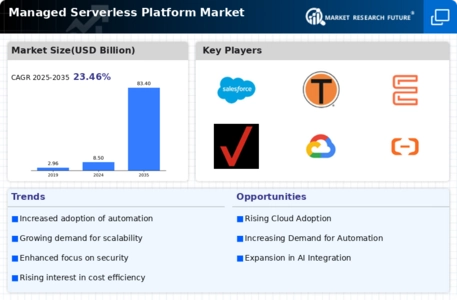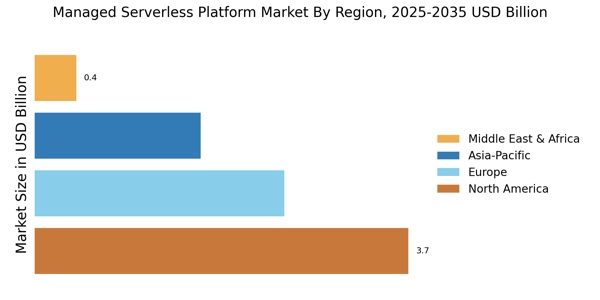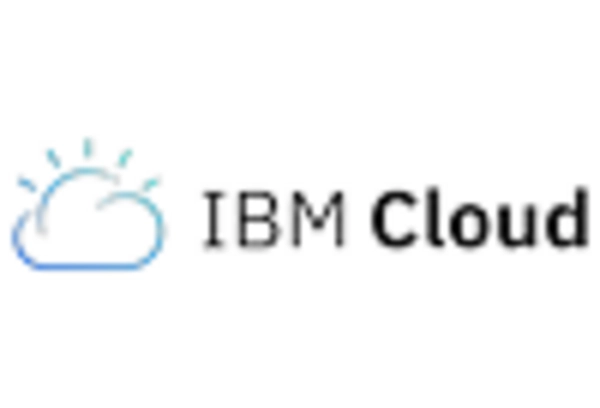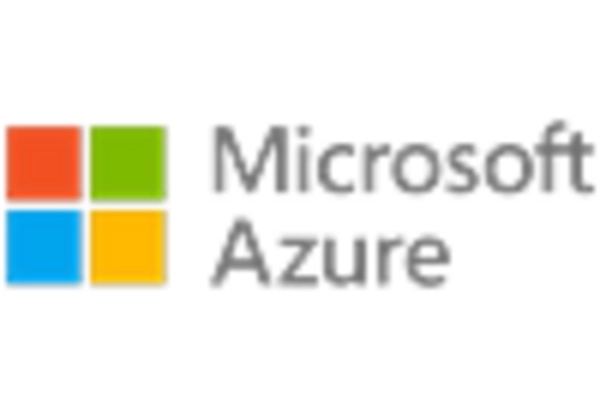Growing Demand for Scalability
The Managed Serverless Platform Market is experiencing a notable surge in demand for scalable solutions. Organizations are increasingly seeking platforms that can effortlessly adjust to fluctuating workloads without the need for manual intervention. This demand is driven by the need for businesses to remain agile and responsive to market changes. According to recent data, the serverless computing market is projected to grow at a compound annual growth rate of over 20% in the coming years. This growth indicates a strong preference for managed serverless platforms that can provide seamless scalability, allowing companies to optimize resource utilization and reduce operational costs. As businesses continue to expand their digital footprints, the ability to scale applications dynamically becomes a critical factor in their success, thereby propelling the Managed Serverless Platform Market forward.
Enhanced Developer Productivity
The Managed Serverless Platform Market is witnessing a transformation in developer productivity. By abstracting the underlying infrastructure, serverless platforms enable developers to focus on writing code rather than managing servers. This shift is particularly beneficial in accelerating the development lifecycle, allowing teams to deploy applications faster and with fewer errors. Recent surveys indicate that organizations utilizing managed serverless platforms report a 40% increase in development speed. This enhancement in productivity is crucial in a competitive landscape where time-to-market can determine success. Additionally, the integration of automated tools and services within these platforms further streamlines workflows, enabling developers to innovate without the constraints of traditional infrastructure management. Consequently, the emphasis on enhancing developer productivity is a significant driver of growth in the Managed Serverless Platform Market.
Cost Efficiency and Resource Optimization
Cost efficiency remains a pivotal driver in the Managed Serverless Platform Market. Organizations are increasingly recognizing the financial benefits of adopting serverless architectures, which eliminate the need for upfront infrastructure investments. By leveraging managed serverless platforms, companies can pay only for the resources they consume, leading to significant cost savings. Recent analyses suggest that businesses can reduce their operational expenses by up to 30% when transitioning to serverless solutions. This financial incentive is particularly appealing to startups and small enterprises that may have limited budgets. Furthermore, the resource optimization capabilities of managed serverless platforms allow organizations to allocate their IT budgets more effectively, focusing on innovation rather than maintenance. As a result, the cost efficiency associated with these platforms is likely to drive further adoption within the Managed Serverless Platform Market.
Focus on Compliance and Security Features
In an era where data breaches and compliance issues are prevalent, the Managed Serverless Platform Market is increasingly focusing on robust security and compliance features. Organizations are prioritizing platforms that offer built-in security measures, such as encryption and access controls, to protect sensitive data. The demand for compliance with regulations, such as GDPR and HIPAA, is driving the need for managed serverless solutions that can ensure adherence to these standards. Recent reports indicate that companies are willing to invest up to 20% more in platforms that provide enhanced security features. This focus on compliance and security not only mitigates risks but also fosters trust among users and stakeholders. As the regulatory landscape continues to evolve, the emphasis on security and compliance will remain a critical driver in the Managed Serverless Platform Market.
Integration with Artificial Intelligence and Machine Learning
The integration of artificial intelligence and machine learning capabilities into managed serverless platforms is emerging as a key driver in the Managed Serverless Platform Market. Organizations are increasingly leveraging these technologies to enhance their applications, enabling smarter decision-making and improved user experiences. The ability to deploy AI and ML models without the complexities of infrastructure management allows businesses to innovate rapidly. Market data suggests that the demand for AI-driven applications is expected to grow significantly, with a projected increase of over 25% in the next few years. This trend indicates that managed serverless platforms that offer seamless integration with AI and ML tools will likely attract more users. As companies strive to harness the power of data analytics and machine learning, the integration capabilities of managed serverless platforms will play a crucial role in their strategic initiatives.


















Leave a Comment